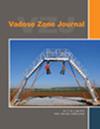Joint multiscale dynamics in soil–vegetation–atmosphere systems: Multifractal cross‐correlation analysis of arid and semiarid rangelands
IF 2.8
3区 地球科学
Q3 ENVIRONMENTAL SCIENCES
引用次数: 0
Abstract
Understanding the dynamics of the soil–vegetation–atmosphere (SVA) system, particularly in arid and semiarid regions, remains challenging due to its intricate and interdependent nature. This system creates problems for rangeland administration, such as insurance and risk management. This paper focuses on the complex interactions within the SVA system, particularly on rangeland ecosystems in Spain's semiarid and arid regions. By employing multifractal detrended cross‐correlation analysis (MFCCA), we explore the joint behavior of key variables, including precipitation (PCP), evapotranspiration (ETP), aridity index (Arid. I.), soil water availability (SWA), biomass (Bio), and normalized difference vegetation index (NDVI). Analyzing a 20‐year data series from Madrid and Almeria provinces, we reveal distinct patterns in the studied variables’ persistence, multifractality, and asymmetry. Notably, the differences in the generalized Hurst exponents ((土壤-植被-大气系统的联合多尺度动力学:干旱和半干旱牧场的多分形交叉相关分析
由于土壤-植被-大气(SVA)系统错综复杂且相互依存,因此了解该系统的动态(尤其是在干旱和半干旱地区)仍然具有挑战性。该系统给牧场管理(如保险和风险管理)带来了问题。本文重点研究 SVA 系统内部复杂的相互作用,尤其是西班牙半干旱和干旱地区的牧场生态系统。通过采用多分形去趋势交叉相关分析 (MFCCA),我们探讨了降水量 (PCP)、蒸散量 (ETP)、干旱指数 (Arid.I.)、土壤水分可用性 (SWA)、生物量 (Bio) 和归一化差异植被指数 (NDVI) 等关键变量的联合行为。通过分析马德里省和阿尔梅里亚省 20 年的数据序列,我们揭示了所研究变量的持续性、多重性和非对称性的独特模式。值得注意的是,马德里和阿尔梅里亚两地在 SWA 与 NDVI、SWA 与 Bio 以及 NDVI 与 Bio 的广义赫斯特指数((q))上的差异突出表明了这两个地区不同的相互作用。此外,多分形分析揭示了两个地区联合变量行为复杂性的差异。阿尔梅里亚各变量的多分形程度较高,表明环境相互作用更为复杂多变,这可能是由于该地区更为干旱所致。这些研究结果表明,阿尔梅里亚对变化的敏感度更高,需要采取适应性管理策略,而在马德里,水供应和相关变量在植被动态中起着更主要的驱动作用。这些研究结果通过多变量协同增效模式揭示了半干旱和干旱地区牧场生态系统的微妙动态,强调了考虑基于复杂性的方法以了解 SVA 系统中关键变量之间错综复杂的相互作用的重要性。
本文章由计算机程序翻译,如有差异,请以英文原文为准。
求助全文
约1分钟内获得全文
求助全文
来源期刊

Vadose Zone Journal
环境科学-环境科学
CiteScore
5.60
自引率
7.10%
发文量
61
审稿时长
3.8 months
期刊介绍:
Vadose Zone Journal is a unique publication outlet for interdisciplinary research and assessment of the vadose zone, the portion of the Critical Zone that comprises the Earth’s critical living surface down to groundwater. It is a peer-reviewed, international journal publishing reviews, original research, and special sections across a wide range of disciplines. Vadose Zone Journal reports fundamental and applied research from disciplinary and multidisciplinary investigations, including assessment and policy analyses, of the mostly unsaturated zone between the soil surface and the groundwater table. The goal is to disseminate information to facilitate science-based decision-making and sustainable management of the vadose zone. Examples of topic areas suitable for VZJ are variably saturated fluid flow, heat and solute transport in granular and fractured media, flow processes in the capillary fringe at or near the water table, water table management, regional and global climate change impacts on the vadose zone, carbon sequestration, design and performance of waste disposal facilities, long-term stewardship of contaminated sites in the vadose zone, biogeochemical transformation processes, microbial processes in shallow and deep formations, bioremediation, and the fate and transport of radionuclides, inorganic and organic chemicals, colloids, viruses, and microorganisms. Articles in VZJ also address yet-to-be-resolved issues, such as how to quantify heterogeneity of subsurface processes and properties, and how to couple physical, chemical, and biological processes across a range of spatial scales from the molecular to the global.
 求助内容:
求助内容: 应助结果提醒方式:
应助结果提醒方式:


